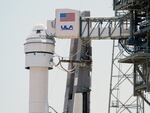
Boeing's Starliner capsule atop an Atlas V rocket is seen at Space Launch Complex 41 at the Cape Canaveral Space Force Station on May 7, a day after its mission to the International Space Station was scrubbed because of an issue with a pressure regulation valve.
John Raoux / AP
The first crewed launch of Boeing's troubled Starliner spacecraft has been delayed again, to May 25, this time because of a helium leak in the service module.
NASA had set the liftoff for May 21 after scrubbing a May 6 launch but the helium leak was discovered on Wednesday. While the agency said the leak in the craft's thruster system was stable and wouldn't pose a risk during the flight, "Boeing teams are working to develop operational procedures to ensure the system retains sufficient performance capability and appropriate redundancy during the flight."
While that work is going on, NASA said its Commercial Crew Program (CCP) and the International Space Station Program will review data and procedures before making a final determination whether to proceed with a countdown.
The delay is the latest for the Starliner's first crewed mission, which will carry NASA astronauts Barry "Butch" Wilmore and Sunita "Suni" Williams to the International Space Station. The astronauts are to spend about a week aboard the space station before making a parachute and airbag-assisted landing in the southwestern U.S.
If that mission is successful, NASA will begin the final process to certify Starliner for crewed rotation missions to the space station.
Related: Launch for Boeing Starliner’s first crewed ride into space has been scrubbed
The delay comes roughly a decade after NASA awarded Boeing a more than $4 billion contract as part of the agency's Commercial Crew Program, which pays private companies to ferry astronauts to and from the space station after the space shuttle was retired in 2011.
SpaceX, which was also awarded a $2 billion contract under the CCP initiative, has flown eight crewed missions for NASA and another four private, crewed spaceflights since 2020.
A history of delays and design problems
But the Starliner program has been plagued with delays and design problems for several years.
It failed to reach the space station during its first mission in 2019 after its onboard clock, which was set incorrectly, caused a computer to fire the capsule's engines too early. The spacecraft successfully docked with the space station during its second test flight in 2022, despite the failure of some thrusters during the launch.
Boeing then scrapped the planned launch of the Starliner's first crewed flight last year, after company officials realized that adhesive tape used on the craft to wrap hundreds of yards of wiring was flammable, and lines connecting the capsule to its three parachutes appeared to be weaker than expected. The launch was delayed indefinitely.
The May 6 launch was scrubbed because of a faulty oxygen relief valve, NASA said.
Related: Boeing finally docks capsule to International Space Station
Wilmore and Williams remain quarantined in Houston and will fly back to NASA's Kennedy Space Center in Florida closer to the new launch date, NASA said. The Starliner, which sits atop a United Launch Alliance Atlas V rocket, remains in the Vertical Integration Facility at Space Launch Complex 41 on Cape Canaveral Space Force Station in Florida.
Boeing has faced intense scrutiny this year on the commercial aviation side of its business after a rear door plug blew out of an Alaska Airlines flight shortly after takeoff in January.
Whistleblowers have since come forward to detail alleged quality control lapses at the storied company, and the Federal Aviation Administration said it was auditing Boeing's production. The Justice Department also announced it would open a criminal investigation into the Alaska Airlines incident.
Copyright 2024 NPR. To see more, visit https://www.npr.org.